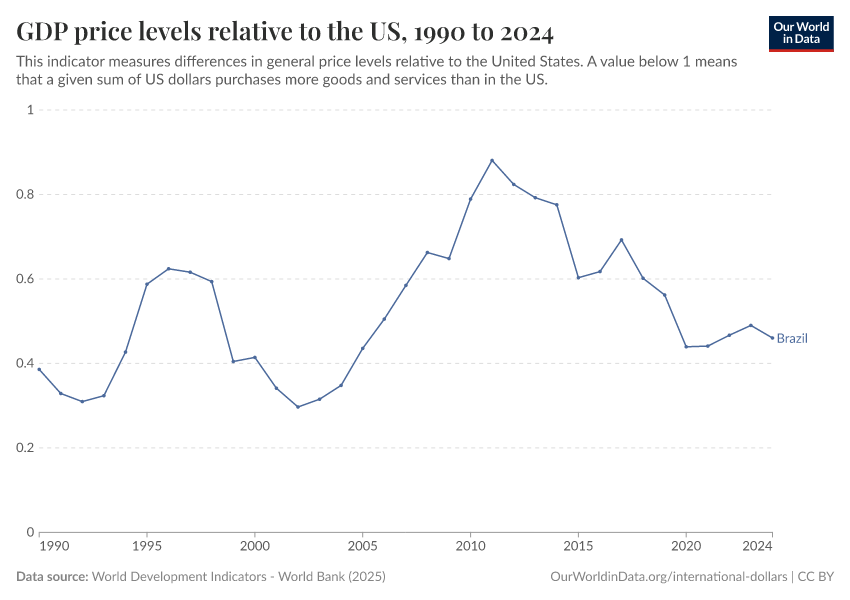GDP price levels relative to the US

What you should know about this indicator
- It shows whether a country’s currency has more or less purchasing power than its exchange rate implies, compared to the United States.
- A value below one means local goods and services are cheaper than in the US, while a value above one suggests local prices are higher.
- These comparisons are based on PPP conversion rates (also called PPP conversion factors or PPP rates). PPP rates estimate how many units of a country’s local currency are needed to buy (roughly) the same basket of goods and services in that country that one US dollar would buy in the United States. For this indicator (at the level of GDP), the comparison is made using a broad, economy-wide basket of goods and services.
- PPP rates are calculated by the International Comparison Program (ICP), which uses the United States as a benchmark country.
- This data is expressed in international-$ at 2021 prices.
What you should know about this indicator
- It shows whether a country’s currency has more or less purchasing power than its exchange rate implies, compared to the United States.
- A value below one means local goods and services are cheaper than in the US, while a value above one suggests local prices are higher.
- These comparisons are based on PPP conversion rates (also called PPP conversion factors or PPP rates). PPP rates estimate how many units of a country’s local currency are needed to buy (roughly) the same basket of goods and services in that country that one US dollar would buy in the United States. For this indicator (at the level of GDP), the comparison is made using a broad, economy-wide basket of goods and services.
- PPP rates are calculated by the International Comparison Program (ICP), which uses the United States as a benchmark country.
- This data is expressed in international-$ at 2021 prices.
Sources and processing
This data is based on the following sources
How we process data at Our World in Data
All data and visualizations on Our World in Data rely on data sourced from one or several original data providers. Preparing this original data involves several processing steps. Depending on the data, this can include standardizing country names and world region definitions, converting units, calculating derived indicators such as per capita measures, as well as adding or adapting metadata such as the name or the description given to an indicator.
At the link below you can find a detailed description of the structure of our data pipeline, including links to all the code used to prepare data across Our World in Data.
Reuse this work
- All data produced by third-party providers and made available by Our World in Data are subject to the license terms from the original providers. Our work would not be possible without the data providers we rely on, so we ask you to always cite them appropriately (see below). This is crucial to allow data providers to continue doing their work, enhancing, maintaining and updating valuable data.
- All data, visualizations, and code produced by Our World in Data are completely open access under the Creative Commons BY license. You have the permission to use, distribute, and reproduce these in any medium, provided the source and authors are credited.
Citations
How to cite this page
To cite this page overall, including any descriptions, FAQs or explanations of the data authored by Our World in Data, please use the following citation:
“Data Page: GDP price levels relative to the US”, part of the following publication: Max Roser, Bertha Rohenkohl, Pablo Arriagada, Joe Hasell, Hannah Ritchie, and Esteban Ortiz-Ospina (2023) - “Economic Growth”. Data adapted from World Development Indicators - World Bank. Retrieved from https://archive.ourworldindata.org/20250916-100934/grapher/gdp-price-levels-relative-to-the-us.html [online resource] (archived on September 16, 2025).How to cite this data
In-line citationIf you have limited space (e.g. in data visualizations), you can use this abbreviated in-line citation:
World Development Indicators - World Bank (2025) – processed by Our World in DataFull citation
World Development Indicators - World Bank (2025) – processed by Our World in Data. “GDP price levels relative to the US – World Bank” [dataset]. World Development Indicators - World Bank, “World Development Indicators 122” [original data]. Retrieved December 5, 2025 from https://archive.ourworldindata.org/20250916-100934/grapher/gdp-price-levels-relative-to-the-us.html (archived on September 16, 2025).